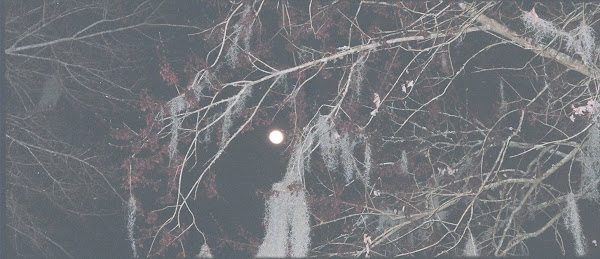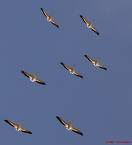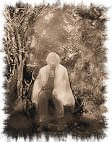

The Theory of Process and The Law of Seven

Introduction
This is a brief summary relating some of the ideas of P. D. Ouspensky and G. I. Gurdjieff with some of the ideas of Arthur M. Young. Such a summary must necessarily be simplistic. That does not mean the actual correlation of these ideas is not profound and broadly-based. It does mean that the expansion of the correlation will not be done here. This will be a sketch, an outline.
One of Arthur M. Young's ideas is a theory of "process". One of the ideas of Gurdjieff and Ouspensky is a fundamental law called the "Law of Seven", which is also a theory of process. This brief paper attempts to establish the common identity of these apparently independent expressions.
Ideally, you are familiar with both of the theories mentioned above. More realistically, I hope you are familiar with at least one or the other of these authors, or it is likely that you would not have read this far. In any case, I assume a deep interest in the subjects addressed by these books in the rest of this discussion.
Both Young and Ouspensky were strongly influenced by ancient tradition and modern science. Both arrived at expressions, both practical and theoretical, of a correlation of these two seemingly diverse influences. Both arrived at remarkably similar conclusions which appear unrelated at first glance.
I say their respective theories "appear unrelated" even though there is the obvious similarity that both have theories of process based on the number seven. That is, both theories claim that process proceeds by seven steps from beginning to end. So much for superficialities. To understand the remarkable parallels between these two theories, we must now look more closely at each.

1.1 The Theory of Process
Arthur M. Young states in The Reflexive Universe that process follows a seven-step pattern which can be seen diagrammatically as a "V" shaped arc, descending through four steps and then ascending back though three steps as so:

Such an apparently simple figure has multiple implications. One implication (the arrow) is that there is a direction in time to process. Process requires time. Also, that process has (seven) distinct steps—that is, it is not a homogeneous continuum from beginning to end but is composed of discrete sections, differentiated portions.
What is most important and what makes this a theory and not an arbitrary division of process, is that the steps are qualifiable and not arbitrary—the second step does not occur before the fourth and never will, for example. The distinctive characteristics and relative positions of each step remain, even when examining enormously different processes.

1.2 The Law of Seven
To begin an examination of the "Law of Seven", I'll here re-introduce what has become a somewhat popular figure in recent years, this is the figure known as the enneagram:

What concerns us in this article in particular is the inner web-like design that connects the points 1-4-2-8-5-7-1, the repeating decimal created by dividing one by seven. It is this part of the enneagram which is specifically related to the seven steps of process. The six numbers represent specific steps or points corresponding to specific qualities or characteristics which proceed in the order given. A seventh point is implied or "potential" and for reasons we will discuss not shown localized in the web pattern.
In order to discuss the Law of Seven with examples as concrete at each step as those afforded by Young's book, I'll use the exposition of it developed by Ouspensky's pupil Rodney Collin in his book The Theory of Celestial Influence. In particular I'll focus on aspects of each step which are not dealt with specifically in Young—the organization of our solar system, the properties of human endocrine glands, and the six processes (see The Six Processes). If there is indeed a correlation between the seven stages of Young's theory of process and the Law of Seven, that should become apparent despite the vast differences in the scale and nature of what is being compared.
One final reminder before we begin. My purpose here is to correlate these theories, not explain the theories themselves. For details concerning the ideas discussed here, see The Reflexive Universe by Arthur M. Young, and The Theory of Celestial Influence by Rodney Collin.

2 The Seven Stages
In this section, we discuss each stage in sequence, so there are seven subsections.
The topics of each subsection look like this:
2.1 Young's Stage 1—Enneagram Position (potential)
2.2 Young's Stage 2—Enneagram Position 5
2.3 Young's Stage 3—Enneagram Position 7
2.4 Young's Stage 4—Enneagram Position 1
2.5 Young's Stage 5—Enneagram Position 4
2.6 Young's Stage 6—Enneagram Position 2
2.7 Young's Stage 7—Enneagram Position 8
So the following discussion (section 2.1) starts with stage 1 in Young's sequence, and correlates that stage to the "potential" position in the enneagram, the next section proceeds to map Young's stage 2 to the enneagram number 5, and so on. It can be seen that this mapping then follows both Young's sequence and the order of the web-like pattern in the enneagram. We discuss each row of this mapping now in turn.

2.1 Young's Stage 1, Enneagram Position (potential)
In which the photon of light is related to the Sun.

2.1.1 Stage 1
In Young, this stage is assigned the power of "potential". It contains within it the seed of that which is to come, as light is matter in potential, or as the simple unicellular bacterium promises the amazing diversity of the plant kingdom. It is interesting to note here that in Young's vast scale of creation in which the seven stages of the arc describe the entire universe as seven "kingdoms", the name of this kingdom is "light". Unlike the next six kingdoms, it is rather oddly placed in the sequence of process because, being of light, it does not in fact exist in time, and so in that sense does not occupy a specific stage in a temporal process. But from it comes the rest, so, from the point-of-view of time (our point-of-view after all), light can be seen as at the beginning.
2.1.2 Position (potential)
We said that this position on the enneagram is in potential, or not specifically represented on the web which connects the six points, and this can best be explained by example. When we use the solar system as our example, each point corresponds to one of the ancient "planets"—the bodies of the solar system visible to the unaided eye—the Moon, Venus, Mercury, Saturn, Mars, Jupiter, and the Sun. Each of these is assigned one of the points (as we will see in the coming sections), but this point, the point of potential which is not localized on the web, is not assigned a point, and corresponds to the Sun. This is reasonable enough in the sense of the solar system in which the Sun is of a different nature than the planetary bodies circling it. To relate the Sun to Young's stage 1, it is believed, for example, that the Sun is the source of the planets and that in one way or another, perhaps by the agency of another passing star, the bodies of the solar system have originated in the Sun. In this way, the Sun represents the planets in potential. Indeed, as we will see, the Sun also represents the potential of the planets.
In addition, the Sun can be said to represent "light", for us, to a superlative degree. In terms of the theory of six processes, this process is the seventh. It represents a higher level which may be seen as the goal of the level in which the six processes are being considered. In the so-called seventh process, all three forces are said to act simultaneously. The symbol that I use to illustrate the six processes (see The Six Processes), when illustrated with colors of light (see A New Symbol), shows this central point as white light.
"Potential", and "light"—characteristics of Young's first stage, seem to relate well to this position in the enneagram.

2.2 Young's Stage 2, Enneagram Position 5
In which the electron and proton are related to the "fight and flight" of the adrenal glands.

2.2.1 Stage 2
Young labels his second stage "substance", and in his arc of creation it is occupied by nuclear particles—the elemental particles that come into being after light, the first stage. This stage is characterized by the attractive and repulsive forces of the primary particles of the atomic nucleus, the proton and electron. The particles themselves possess no unique identity, in that one proton is like any other proton, and one electron like any other electron. The difference between protons and electrons, of course, is huge, if not best described as opposite in everything from size to properties.
The other term Young uses to describe this stage is "binding", which seems to represent only one side of the coin. I think a better term would be something like "attraction/repulsion", or "opposites", or simply "force". With protons and electrons we see the repulsion of identical charges (electrons repel electrons and protons repel protons) and the attraction of opposites (electrons and protons attract each other).
"...the photon's creation of the first so-called particles, or protons (called pair creation) also creates an enormous force 10**39 times gravity. This force is so great that nothing can exist until it neutralizes itself in the joining of positive and negative "particles" (proton and electron) in atoms that do exist."
A. M. Young, The Four Levels of Process
What was characteristic of the previous stage was light, the photon. What is characteristic of this stage is these elemental particles in an unbound state due to the tremendous force liberated.
2.2.2 Position 5
Collin's type associated with this stage, the Martial, has powerful likes and dislikes. If you are the friend of a Martial, they will be tremendously loyal. If you are their enemy, they make it clear.
While it is hard to relate Young's stage 2 to the planet Mars which occupies this position in the enneagram, it is more clearly seen in the endocrine gland associated with this position, the adrenal glands. The characteristic fight or flight reaction produced by the adrenaline (epinephrine) from this gland is known to us all, and seems to echo the concept of attractive and repulsive forces among the nuclear particles.
In addition, the very structure of the adrenals is curiously evocative of the nuclear particles. The two adrenal glands within us are "virtually identical" [Encyc Brit], that is, they possess no unique identity or function of their own. They are, however, each comprised of two parts which could hardly be more different from one another—an outer cortex and an inner medulla. The cortex comprises about 90% of the gland and secretes male hormones. The small inner medulla secretes the adrenaline and noradrenaline (or epinephrine and norepinephrine) which are nearly identical substances with nearly identical effects. So between the two adrenal glands and the two substances of the adrenal medulla we see those attributes of both lack of identity and existence of polarity which characterize this step.
In terms of the six processes, this is the process 1-3-2, or the process of destruction. It is characterized by the splitting, the division, of a previous whole. Simple examples are the breaking of eggs prior to cooking, or the breaking of rocks for gravel.

2.3 Young's Stage 3, Enneagram Position 7
In which "identity" is related to the Jovian system.

2.3.1 Stage 3
Young's third stage is characterized by "identity". Note that in Young's progression through the seven stages of process, each new stage adds a characteristic lacking in a previous stage. It is the new quality of each stage that tends to distinguish it, as the lack of identity of the subjects of the previous stage are superseded by subjects with identity in this stage. This stage corresponds to the kingdom of atoms, which are the same faceless electrons and protons now combined in such a way as to create unique identities for over 100 different atoms. Young describes other characteristics of this stage as "acquiring its own center" as an atom possesses a nucleus surrounded by electron "shells", or "orbits".
2.3.2 Position 7
The seventh position on the enneagram is assigned to Jupiter. Jupiter is the first planet (going out from the Sun) that clearly represents a solar system in miniature, as it is encircled by a large array of planet-like satellites, appears to be composed largely of hydrogen and helium in proportions very similar to the Sun, and even radiates more energy than it receives. So, we can see the beginning, or at least a simulation of, a new system with an identity independent of the Sun.
In brief, the endocrine gland associated with position 7 is the posterior pituitary which is responsible for the uterine contractions which give birth to the new individual. This also seems to reflect the kind of mother-child relationship we see between the Sun and Jupiter, but I don't mean this to be convincing to reason, only evocative to intuition.
Of the six processes, the process 2-1-3, or refinement, is indicated here.

2.4 Young's Stage 4, Enneagram Position 1
In which the kingdom of molecules is compared to the moon.

2.4.1 Stage 4
Young shows stage 4 at the bottom of his arc, at the turning point as it were between the matter and the life of creation. He labels this kingdom "Molecular" and characterizes it by "complex combination". This kingdom is the most deterministic and constrained of all of Young's kingdoms.
2.4.2 Position 1
When the enneagram is used as a model of the solar system, position 1 (here associated with Young's stage 4) is occupied by the Moon and, when the enneagram is used to model the human endocrine system, the position is occupied by the pancreas.
The "complex combination" Young describes for this stage may be seen in the peculiar compound exocrine and endocrine functions of the pancreas. The exocrine functions are involved in the digestion (breakdown of complex structures) of fats, carbohydrates, and proteins. The endocrine functions are concerned with secreting hormones such as insulin which regulate blood metabolism. It is interesting to note that the cells involved with secreting the digestive enzymes are grouped in such a way as to be given the name "acinar cells" from the Latin word for grapes to describe their combined appearance.
I'd only add here that there seems to be another way of expressing this stage/position as something like "peculiar" or "extreme identity" to relate it to the previous stage as more of a further or extreme development of unique identity.
I don't see how the moon, per se, relates to complex combination or the molecular attributes of this stage, although it is possible that all matter on the moon is molecular, i.e., nothing is in elemental form as, say, gold may be on Earth. Perhaps the "uniqueness" of our moon may be seen in its strangely close position relative in size to its planetary host as compared to other planet's satellites.
Of the six processes, this is the process of growth. Growth can be seen in the molecular kingdom as simple addition of atoms, an addition which can create relatively enormous molecules. In the fourth way's ray of creation, the Moon is the growing end of the ray.
[More clear connections between this stage and the corresponding position on the enneagram can be seen by looking at other aspects of these theories, such as the degrees of freedom discussed by Young and the role of the moon as discussed by Collin but that is beyond the scope of this article. I only mention it as a pointer for those already well-versed in these ideas.]

2.5 Young's Stage 5, Enneagram Position 4
In which health and plants are related to Venus.

2.5.1 Stage 5
Young's kingdom here is "Plants", and the power associated with this kingdom is "organization". This organization is demonstrated in negative-entropy, that is, the storage of energy, and in hierarchical structures, that is, the purposeful organization of self-contained functions. It is at this stage in Young's arc that the turn has been taken—what was the arrow of process descending ever deeper into matter now becomes ascending and "life" is introduced.
2.5.2 Position 4
On the enneagram, this point is represented by the planet Venus, and by the endocrine function of the parathyroids. The parathyroid is responsible for regulating blood calcium and phosphorus. Phosphorus is "one of the most important minerals for cellular activity" Also, "calcium phosphate is the principal inorganic constituent of teeth and bones"—arguably, our most plant-like parts. And, "[phosphorus] is indispensable to life, being intimately involved in energy transfer and in the passage of deoxyribonucleic acid (DNA) of all cells." [Quotes are from the Encyclopedia Britannica.]
The most obvious thing about Venus is, of course, the heavy cloud cover that surrounds the planet (which produces an exaggerated "greenhouse effect"). This position, proceeding to the next position, crosses by the point of the triangle associated with breath in the human body and atmosphere on planets. While there seems no possibility of plant life on Venus, there is no denying the profound interrelationship of atmosphere and the plant kingdom on our planet.
Of the six processes, the triad 2-3-1, or healing, belongs here.

2.6 Young's Stage 6, Enneagram Position 2
In which the motility of animals is related to that wanderer Mercury.

2.6.1 Stage 6
This stage is represented by the kingdom "Animals" and has the power of "mobility".
2.6.2 Position 2
This is the position corresponding to the thyroid gland and the planet Mercury. Mobility of Mercury can be seen in its rapid revolution around the Sun and, from our point of view on earth, its rapid and erratic movement in the night skies. Closer to home, the thyroid gland is responsible for much movement, and over-stimulation of this gland leads to increased motor activity, such as restlessness, facial twitches, excessive gesturing, and so on.
Of the six processes, the triad 3-1-2, or corruption, is the triad in which the lower attacks the higher to reduce it to matter. This is the very nature of the animal kingdom, the kingdom that must kill to feed.

2.7 Young's Stage 7, Enneagram Position 8
In which the dominion of humanity is related to Saturn and the "master gland".

2.7.1 Stage 7
In Young's theory, this stage is represented as the power of "dominion" and the kingdom of "man". ("Man" is shown literally in parenthesis in his discussion to denote the unfinished nature of this kingdom - very much like G's "man in quotation marks".)
Dominion in this case is perhaps an obvious name, as with tools and wits humans have acquired a vast dominion over (and responsibility for) their world. We can see this dominion applied with ever greater efficacy to all the other kingdoms of Young's arc.
2.7.2 Position 8
This position corresponds to the planet Saturn and the anterior pituitary endocrine gland. The anterior pituitary is sometimes referred to as the "master" gland because of the role it plays in secreting the hormones that control much of endocrine activity.
This triad in the six processes is 3-2-1, or regeneration.

For those familiar with the type information, a few interesting symmetries may be observed when the types are mapped to the arc:

The four active types are in the two red rows at the top, and the three passive types are in the two blue rows at the bottom. A different symmetry can be seen for the positive-negative duality of types (indicated by + and -): in this case, positive and negative type alternate between rows, so that, for example, Level I has two positive types, Level II two negative types.

I have no idea how familiar Arthur M. Young was with the ideas of the fourth way. The more I study his writings, the more I am struck by the common ground, but at least part of this similarity may be due to the common intent - to divine, as it were, the structures and processes of the universe without beginning with implicit acceptance of modern western thought on the matter. As far as I know, Mr. Young never acknowledged the fourth way as one of his inspirations, and I believe he would not have hesitated to do so if it was.
I should add that I view Young (and everything else for that matter) from the point of view of the fourth way, and I consider his life work supportive but not crucial to this view. In particular, I find his "cosmology" fruitful, but not his ideas on human psychology. Fourth way psychology begins with several basics, and the inability of every other approach to realize even one of these basics indicates the state of other "psychologies".
3 So What?
The question ("So what?"), in this context, has two meanings. One, so what if this is true? The other, so what good is this hazy "correlation"?
The latter first: I don't pretend to convince with what I've written. Reading it over again and again I realize how insufficient it is in itself, to anyone trained in scientific thought and unversed in the theories themselves. Yet to someone familiar with both of these theories I suspect that I have struck a chord. To someone well-versed in one or the other, I do not doubt that this will lead to further investigations. To myself, I feel like my hands have been tied in writing this—I could not possibly, without fully describing each theory (and I certainly could not do that as well as the authors mentioned above), point out all the similarities which have finally and firmly created in me the conviction that they are parallel expressions.
But then to address the first objection: What good is this even if it is true? To that I can only refer to the scope, the nature, of what it is we are talking about. Nothing less than fundamental law. It is as if we are like the early cave-dwellers, some kind of pre- or early-Homo sapiens, who, looking around them at the mystery of this world, just could not quite grasp laws that seemed everywhere apparent and yet elusive, laws that led their successors to discover the control of fire, the creation of tools, the prediction of the seasons.
I don't see any reason to believe we are at the end point, or even nearly so, of final understanding. It seems to me much more likely that we, just like every age of humanity that we know about, only mistakenly believe that we know just about everything, but are in fact, like those cave-dwellers, just beginning to somehow intuit new laws, new ways of perceiving this world.
I think that is what these theories are about. They do not, in any way, "throw out the baby with the bath water", but instead fully intend to comprehend and include the stunning achievements of modern science in th
eir world view. If that world view does not mesh with what we know in other ways, it is suspect. But if that new view so includes modern physics as to propose a true new metaphysics, we must certainly be interested. Really, I think we somehow know and expect that this is coming.
Perhaps obviously, I do not think that these are just additional theories, additional "contenders for the throne". I do think that a new understanding is coming of just these very theories and the body of ideas related to each. It has been my intention here to bring these two theories together to bring their ponderers together. Each has much to offer the other.

Dear Readers, please do not assume that you understand anything you read on this blog. Written here is the language of spirit.


.jpg)

.jpg)
.jpg)


